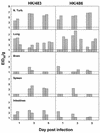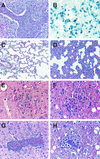Pathogenesis of avian influenza A (H5N1) viruses in ferrets
- PMID: 11932409
- PMCID: PMC155091
- DOI: 10.1128/jvi.76.9.4420-4429.2002
Pathogenesis of avian influenza A (H5N1) viruses in ferrets
Abstract
Highly pathogenic avian influenza A H5N1 viruses caused outbreaks of disease in domestic poultry and humans in Hong Kong in 1997. Direct transmission of the H5N1 viruses from birds to humans resulted in 18 documented cases of respiratory illness, including six deaths. Here we evaluated two of the avian H5N1 viruses isolated from humans for their ability to replicate and cause disease in outbred ferrets. A/Hong Kong/483/97 virus was isolated from a fatal case and was highly pathogenic in the BALB/c mouse model, whereas A/Hong Kong/486/97 virus was isolated from a case with mild illness and exhibited a low-pathogenicity phenotype in mice. Ferrets infected intranasally with 10(7) 50% egg infectious doses (EID(50)) of either H5N1 virus exhibited severe lethargy, fever, weight loss, transient lymphopenia, and replication in the upper and lower respiratory tract, as well as multiple systemic organs, including the brain. Gastrointestinal symptoms were seen in some animals. In contrast, weight loss and severe lethargy were not noted in ferrets infected with 10(7) EID(50) of two recent human H3N2 viruses, although these viruses were also isolated from the brains, but not other extrapulmonary organs, of infected animals. The results demonstrate that both H5N1 viruses were highly virulent in the outbred ferret model, unlike the differential pathogenicity documented in inbred BALB/c mice. We propose the ferret as an alternative model system for the study of these highly pathogenic avian viruses.
Figures




References
-
- Campbell, D., C. Sweet, and H. Smith. 1979. Comparisons of virulence of influenza virus recombinants in ferrets in relation to their behavior in man and their genetic constitution. J. Gen. Virol. 44:37-44. - PubMed
-
- Claas, E. C. J., A. D. M. E. Osterhaus, R. Van Beek, J. C. De Jong, G. F. Rimmelzwaan, D. A. Senne, S. Krauss, K. F. Shortridge, and R. G. Webster. 1998. Human influenza A H5N1 virus related to a highly pathogenic avian influenza virus. Lancet 351:472-477. - PubMed
-
- Donnelly, J. J., A. Friedman, J. B. Ulmer, and M. A. Liu. 1997. Further protection against antigenic drift of influenza virus in a ferret model by DNA vaccination. Vaccine 15:865-868. - PubMed
Publication types
MeSH terms
LinkOut - more resources
Full Text Sources
Other Literature Sources
Medical

